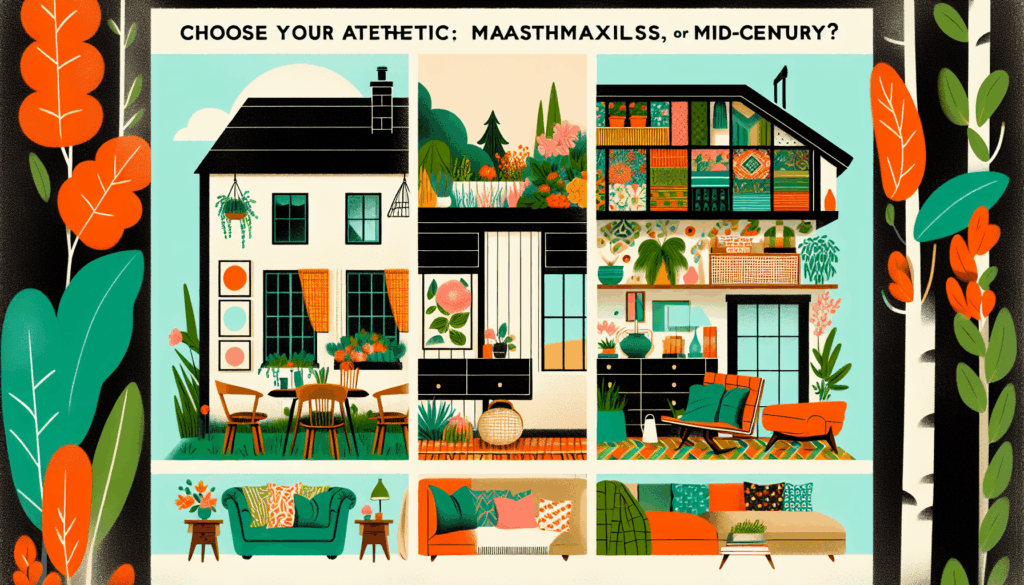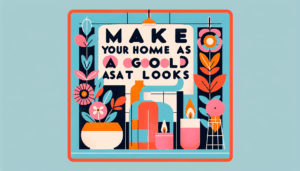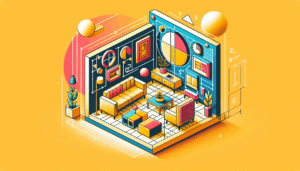In the ever-evolving world of interior design and personal style, aesthetics play a crucial role in how we express ourselves and create our environments. Among the myriad of design movements, three prominent styles have emerged as favorites: Cottagecore, Maximalism, and Mid-Century Modern. Each aesthetic offers a unique lens through which we can view our spaces and lifestyles. In this blog, we will delve into the characteristics of each style, their historical contexts, and how you can incorporate elements from these aesthetics into your home and life.

Cottagecore: Embracing Nostalgia and Nature
Cottagecore is a romanticized interpretation of rural life, drawing inspiration from the simplicity and beauty of nature. This aesthetic celebrates the quaint and cozy, often evoking images of idyllic cottages surrounded by lush gardens and wildflowers. But what exactly makes Cottagecore so appealing?
Characteristics of Cottagecore
1. Natural Materials: Cottagecore emphasizes the use of organic materials such as wood, stone, and linen. Furniture is often rustic and handmade, contributing to a sense of warmth and authenticity.
2. Floral Patterns: Floral prints are ubiquitous in Cottagecore design. From wallpaper to upholstery, these patterns bring the beauty of the outdoors inside, creating a tranquil and inviting atmosphere.
3. Vintage and Antique Finds: The charm of Cottagecore often lies in its embrace of vintage items. Thrifted treasures, heirloom pieces, and handcrafted goods add character and history to any space.
4. Cozy Textiles: Soft textiles like knitted blankets, wool throws, and cotton cushions contribute to the comfort of a Cottagecore home. Layering these textiles creates a sense of warmth and security.
5. Connection to Nature: Cottagecore encourages a harmonious relationship with nature. Houseplants, fresh flowers, and natural light play essential roles in creating a serene environment.
Incorporating Cottagecore into Your Life
To bring Cottagecore into your own space, start with a few small changes. Consider adding some plants or herbs to your kitchen windowsill, incorporating floral-patterned textiles, or displaying vintage finds on your shelves. Embrace a slower pace of life by taking time to enjoy simple pleasures like baking bread or tending to your garden. Cottagecore invites you to savor the moments that often go unnoticed in our fast-paced world.
Maximalism: Bold and Expressive
In stark contrast to the minimalist trends that have dominated interior design in recent years, Maximalism celebrates abundance and individuality. This aesthetic is all about making a statement, using color, pattern, and texture to create an immersive experience. It encourages creativity and self-expression, allowing for a space that feels vibrant and alive.
Characteristics of Maximalism
1. Vibrant Colors: Maximalism embraces bold colors and unexpected combinations. From jewel tones to neon accents, the palette is often daring and exuberant.
2. Layered Patterns: Mixing and matching patterns is a hallmark of Maximalism. Floral prints, geometric designs, and animal motifs can coexist harmoniously in a single space.
3. Eclectic Decor: Maximalist interiors are a reflection of the owner’s personality. Collections of art, knickknacks, and personal mementos come together to create a unique narrative.
4. Textural Variety: A diverse range of textures adds depth to Maximalist spaces. Think velvet cushions, woven rugs, and shiny metallics all in one room.
5. Statement Pieces: Maximalism thrives on the presence of eye-catching focal points, such as oversized artwork, bold furniture, or dramatic lighting fixtures.
Embracing Maximalism in Your Home
To adopt a Maximalist approach, start by curating a collection of items that resonate with you. Be fearless in your choices; mix patterns and colors that speak to your individuality. Don’t shy away from bold statement pieces that can serve as conversation starters. Remember, Maximalism is about celebrating your unique style, so let your personality shine through in every corner of your home.
Mid-Century Modern: Timeless Elegance
Mid-Century Modern is an aesthetic that emerged during the mid-20th century, characterized by clean lines, organic shapes, and a focus on functionality. This design movement revolutionized the way people viewed furniture and architecture, creating spaces that were both stylish and practical.
Characteristics of Mid-Century Modern
1. Clean Lines: Mid-Century Modern design is known for its simplicity and elegance. Furniture often features sleek lines and minimal ornamentation, creating a timeless appeal.
2. Organic Shapes: Curves and organic forms are prevalent in Mid-Century design. This softness contrasts beautifully with the straight lines, creating a balanced aesthetic.
3. Functional Design: The focus on usability is a core principle of Mid-Century Modern. Furniture is designed with practicality in mind, ensuring that it serves a purpose while looking stylish.
4. Natural Materials: Similar to Cottagecore, Mid-Century design favors natural materials like wood, leather, and stone. These materials enhance the connection to nature and add warmth to interiors.
5. Bold Colors and Patterns: While Mid-Century Modern leans toward a more subdued palette, it also embraces bold accent colors and geometric patterns that evoke the spirit of the era.
Infusing Mid-Century Modern into Your Space
To incorporate Mid-Century Modern elements into your home, consider investing in classic furniture pieces, such as an Eames chair or a teak coffee table. Use a neutral base for your walls and larger furniture to allow for colorful accents through art and decor. Focus on creating a functional space that still feels inviting and stylish.
Conclusion: Finding Your Aesthetic
Choosing an aesthetic is a deeply personal journey. Whether you are drawn to the pastoral charm of Cottagecore, the vibrant expressiveness of Maximalism, or the timeless elegance of Mid-Century Modern, each style offers unique ways to express your identity and create a space that feels like home.
As you explore these aesthetics, remember that you don’t have to conform to just one style. Many individuals find joy in blending elements from different aesthetics to create a personalized sanctuary. Take your time to discover what resonates with you, and let your home reflect your personality and passions. After all, your space should be a true reflection of who you are.
AI-Assisted Content Disclaimer
This article was created with AI assistance and reviewed by a human for accuracy and clarity.






Leave a Reply